Analyzing NDSS Pamphlet: Diabetes and Community Health in Australia
VerifiedAdded on 2022/08/20
|8
|1646
|10
Report
AI Summary
This report critically analyzes an Australian health promotion pamphlet concerning diabetes, focusing on the National Diabetes Services Scheme (NDSS) and its impact on the Australian community. The assignment explores the target audience, which includes adults with diabetes, and the prevalence of diabetes within different demographic groups, particularly the Aboriginal and Torres Strait Islander population. It examines the relevance of the health message, which emphasizes the importance of blood glucose management, risk factors, and the types of diabetes. The report details the NDSS program, its services, and how it supports individuals with diabetes through subsidized products and online resources. The analysis further assesses how the NDSS aligns with the Ottawa Charter's health promotion strategies, specifically 'Advocate' and 'Enable', and discusses the application of this knowledge in future nursing practice, emphasizing the need for health promotion, supportive environments, and community action. The report uses data from AIHW and other sources to support its claims, providing insights into the challenges of diabetes management and the role of health promotion in addressing the condition in Australia.
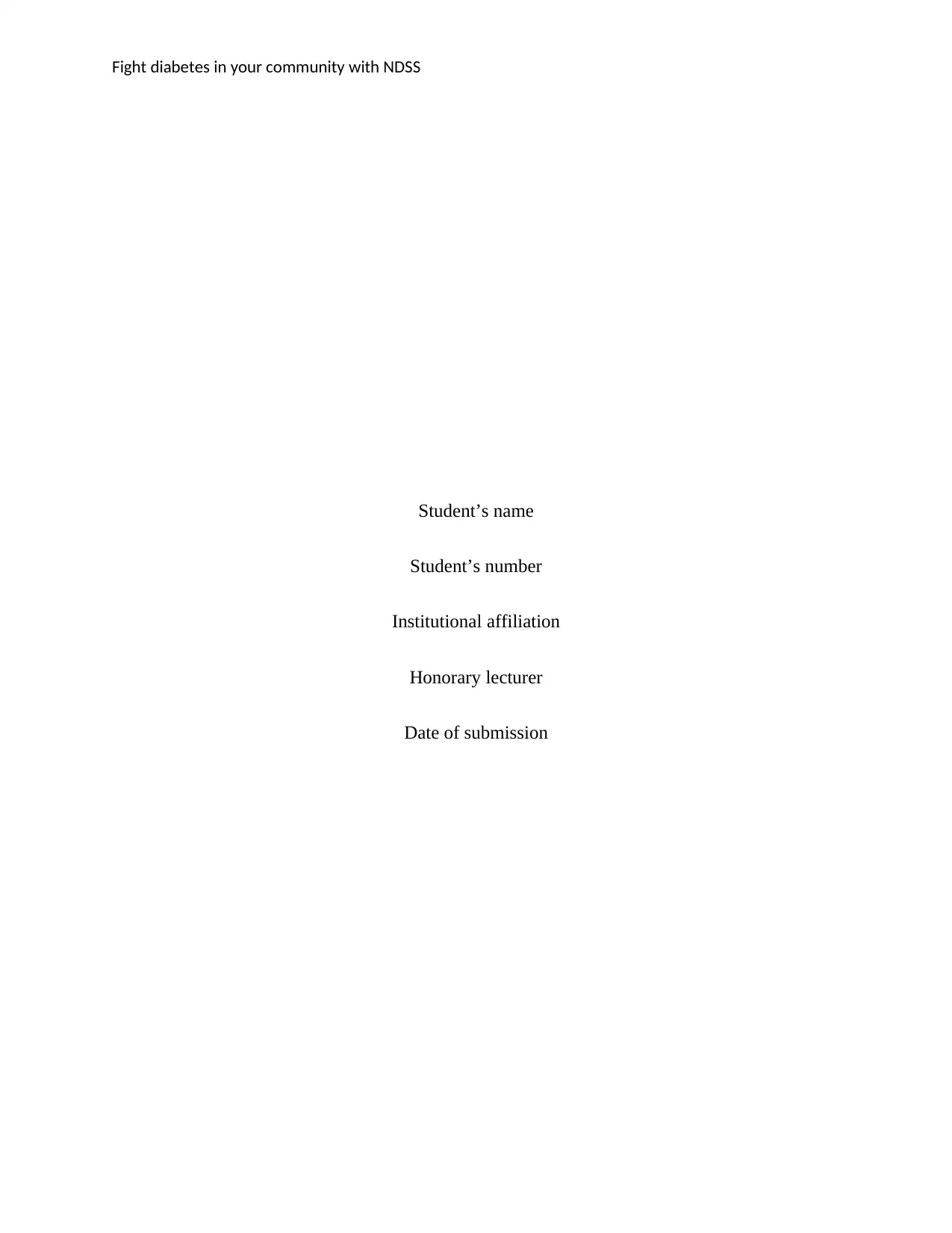
Fight diabetes in your community with NDSS
Student’s name
Student’s number
Institutional affiliation
Honorary lecturer
Date of submission
Student’s name
Student’s number
Institutional affiliation
Honorary lecturer
Date of submission
Paraphrase This Document
Need a fresh take? Get an instant paraphrase of this document with our AI Paraphraser
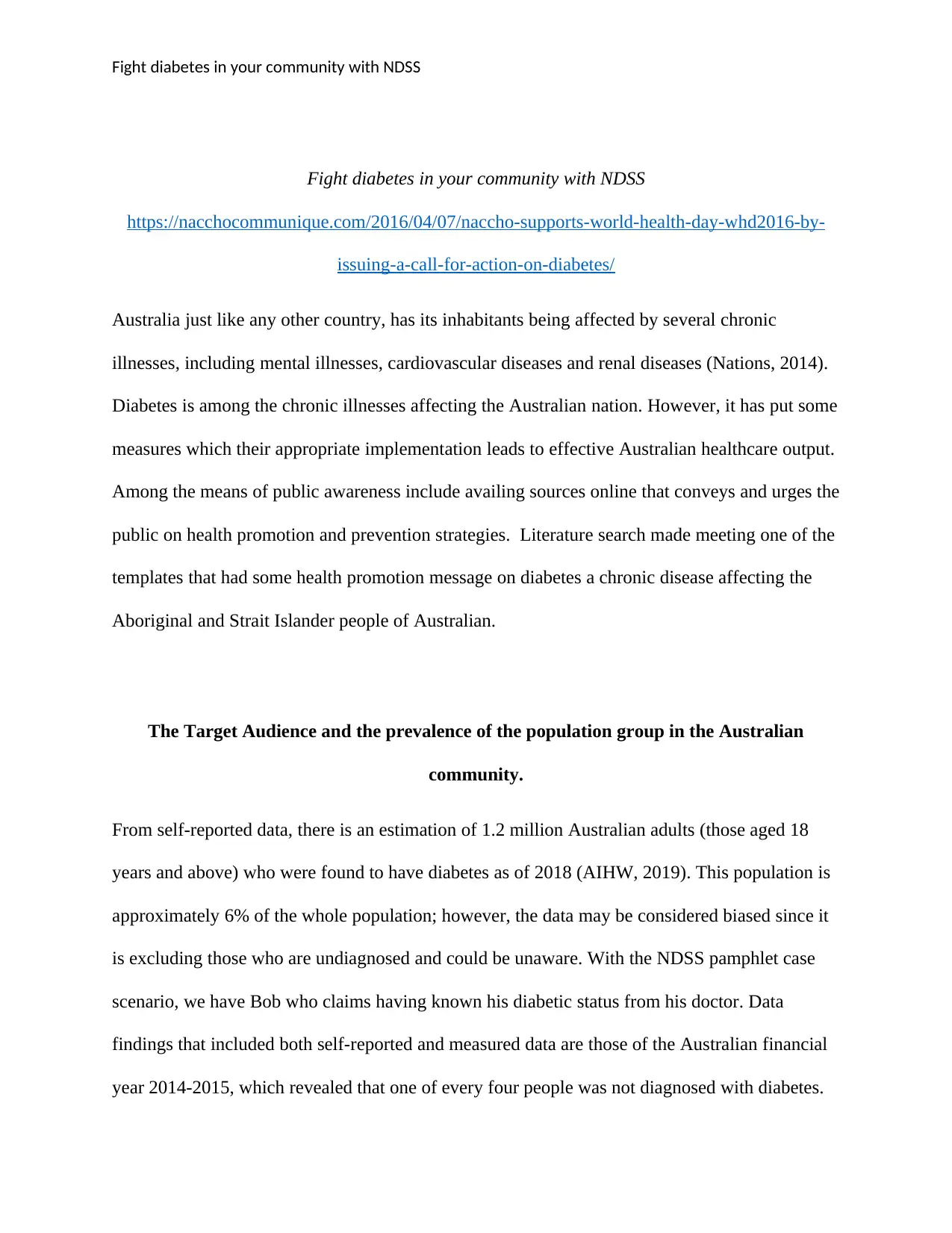
Fight diabetes in your community with NDSS
Fight diabetes in your community with NDSS
https://nacchocommunique.com/2016/04/07/naccho-supports-world-health-day-whd2016-by-
issuing-a-call-for-action-on-diabetes/
Australia just like any other country, has its inhabitants being affected by several chronic
illnesses, including mental illnesses, cardiovascular diseases and renal diseases (Nations, 2014).
Diabetes is among the chronic illnesses affecting the Australian nation. However, it has put some
measures which their appropriate implementation leads to effective Australian healthcare output.
Among the means of public awareness include availing sources online that conveys and urges the
public on health promotion and prevention strategies. Literature search made meeting one of the
templates that had some health promotion message on diabetes a chronic disease affecting the
Aboriginal and Strait Islander people of Australian.
The Target Audience and the prevalence of the population group in the Australian
community.
From self-reported data, there is an estimation of 1.2 million Australian adults (those aged 18
years and above) who were found to have diabetes as of 2018 (AIHW, 2019). This population is
approximately 6% of the whole population; however, the data may be considered biased since it
is excluding those who are undiagnosed and could be unaware. With the NDSS pamphlet case
scenario, we have Bob who claims having known his diabetic status from his doctor. Data
findings that included both self-reported and measured data are those of the Australian financial
year 2014-2015, which revealed that one of every four people was not diagnosed with diabetes.
Fight diabetes in your community with NDSS
https://nacchocommunique.com/2016/04/07/naccho-supports-world-health-day-whd2016-by-
issuing-a-call-for-action-on-diabetes/
Australia just like any other country, has its inhabitants being affected by several chronic
illnesses, including mental illnesses, cardiovascular diseases and renal diseases (Nations, 2014).
Diabetes is among the chronic illnesses affecting the Australian nation. However, it has put some
measures which their appropriate implementation leads to effective Australian healthcare output.
Among the means of public awareness include availing sources online that conveys and urges the
public on health promotion and prevention strategies. Literature search made meeting one of the
templates that had some health promotion message on diabetes a chronic disease affecting the
Aboriginal and Strait Islander people of Australian.
The Target Audience and the prevalence of the population group in the Australian
community.
From self-reported data, there is an estimation of 1.2 million Australian adults (those aged 18
years and above) who were found to have diabetes as of 2018 (AIHW, 2019). This population is
approximately 6% of the whole population; however, the data may be considered biased since it
is excluding those who are undiagnosed and could be unaware. With the NDSS pamphlet case
scenario, we have Bob who claims having known his diabetic status from his doctor. Data
findings that included both self-reported and measured data are those of the Australian financial
year 2014-2015, which revealed that one of every four people was not diagnosed with diabetes.
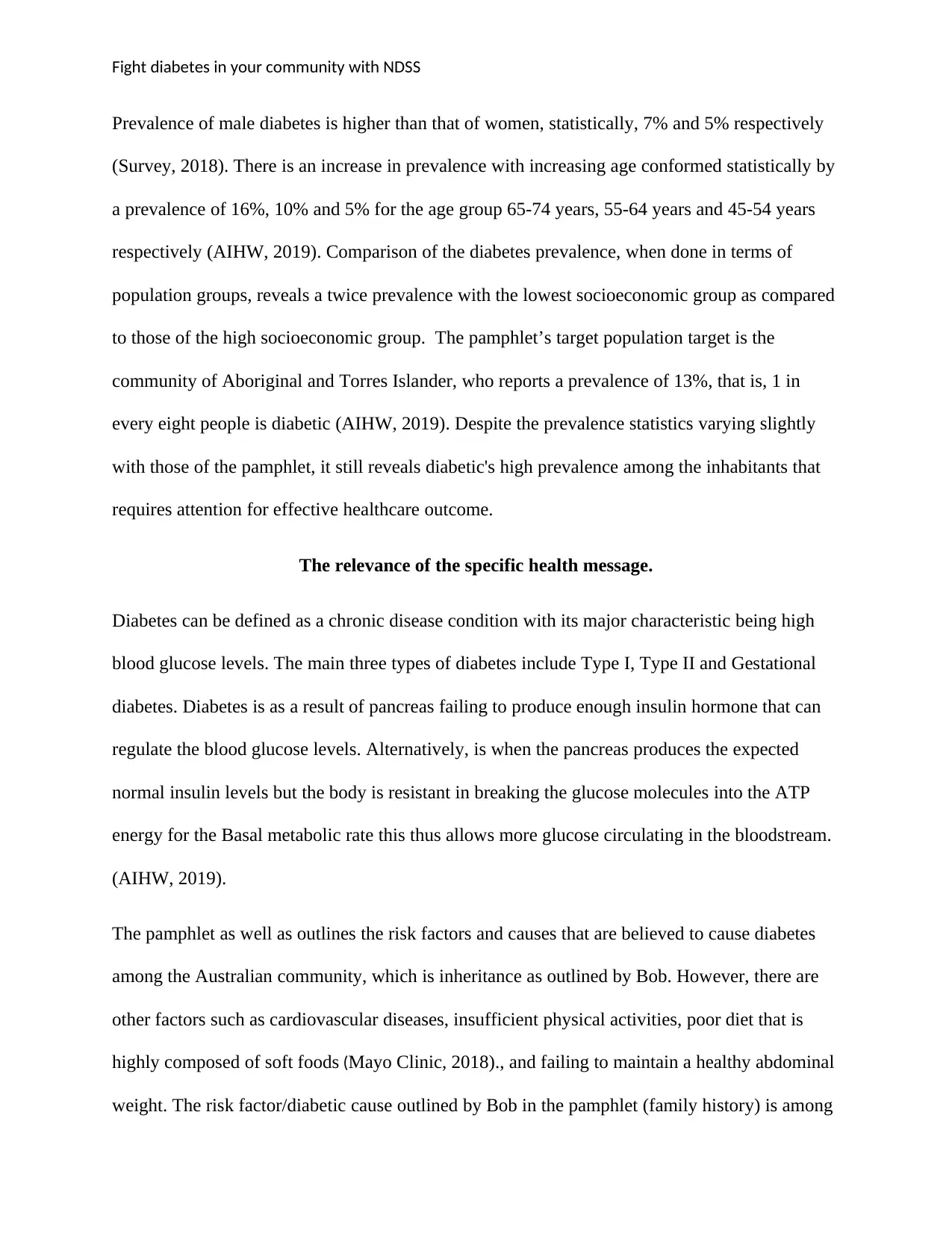
Fight diabetes in your community with NDSS
Prevalence of male diabetes is higher than that of women, statistically, 7% and 5% respectively
(Survey, 2018). There is an increase in prevalence with increasing age conformed statistically by
a prevalence of 16%, 10% and 5% for the age group 65-74 years, 55-64 years and 45-54 years
respectively (AIHW, 2019). Comparison of the diabetes prevalence, when done in terms of
population groups, reveals a twice prevalence with the lowest socioeconomic group as compared
to those of the high socioeconomic group. The pamphlet’s target population target is the
community of Aboriginal and Torres Islander, who reports a prevalence of 13%, that is, 1 in
every eight people is diabetic (AIHW, 2019). Despite the prevalence statistics varying slightly
with those of the pamphlet, it still reveals diabetic's high prevalence among the inhabitants that
requires attention for effective healthcare outcome.
The relevance of the specific health message.
Diabetes can be defined as a chronic disease condition with its major characteristic being high
blood glucose levels. The main three types of diabetes include Type I, Type II and Gestational
diabetes. Diabetes is as a result of pancreas failing to produce enough insulin hormone that can
regulate the blood glucose levels. Alternatively, is when the pancreas produces the expected
normal insulin levels but the body is resistant in breaking the glucose molecules into the ATP
energy for the Basal metabolic rate this thus allows more glucose circulating in the bloodstream.
(AIHW, 2019).
The pamphlet as well as outlines the risk factors and causes that are believed to cause diabetes
among the Australian community, which is inheritance as outlined by Bob. However, there are
other factors such as cardiovascular diseases, insufficient physical activities, poor diet that is
highly composed of soft foods (Mayo Clinic, 2018)., and failing to maintain a healthy abdominal
weight. The risk factor/diabetic cause outlined by Bob in the pamphlet (family history) is among
Prevalence of male diabetes is higher than that of women, statistically, 7% and 5% respectively
(Survey, 2018). There is an increase in prevalence with increasing age conformed statistically by
a prevalence of 16%, 10% and 5% for the age group 65-74 years, 55-64 years and 45-54 years
respectively (AIHW, 2019). Comparison of the diabetes prevalence, when done in terms of
population groups, reveals a twice prevalence with the lowest socioeconomic group as compared
to those of the high socioeconomic group. The pamphlet’s target population target is the
community of Aboriginal and Torres Islander, who reports a prevalence of 13%, that is, 1 in
every eight people is diabetic (AIHW, 2019). Despite the prevalence statistics varying slightly
with those of the pamphlet, it still reveals diabetic's high prevalence among the inhabitants that
requires attention for effective healthcare outcome.
The relevance of the specific health message.
Diabetes can be defined as a chronic disease condition with its major characteristic being high
blood glucose levels. The main three types of diabetes include Type I, Type II and Gestational
diabetes. Diabetes is as a result of pancreas failing to produce enough insulin hormone that can
regulate the blood glucose levels. Alternatively, is when the pancreas produces the expected
normal insulin levels but the body is resistant in breaking the glucose molecules into the ATP
energy for the Basal metabolic rate this thus allows more glucose circulating in the bloodstream.
(AIHW, 2019).
The pamphlet as well as outlines the risk factors and causes that are believed to cause diabetes
among the Australian community, which is inheritance as outlined by Bob. However, there are
other factors such as cardiovascular diseases, insufficient physical activities, poor diet that is
highly composed of soft foods (Mayo Clinic, 2018)., and failing to maintain a healthy abdominal
weight. The risk factor/diabetic cause outlined by Bob in the pamphlet (family history) is among
⊘ This is a preview!⊘
Do you want full access?
Subscribe today to unlock all pages.

Trusted by 1+ million students worldwide
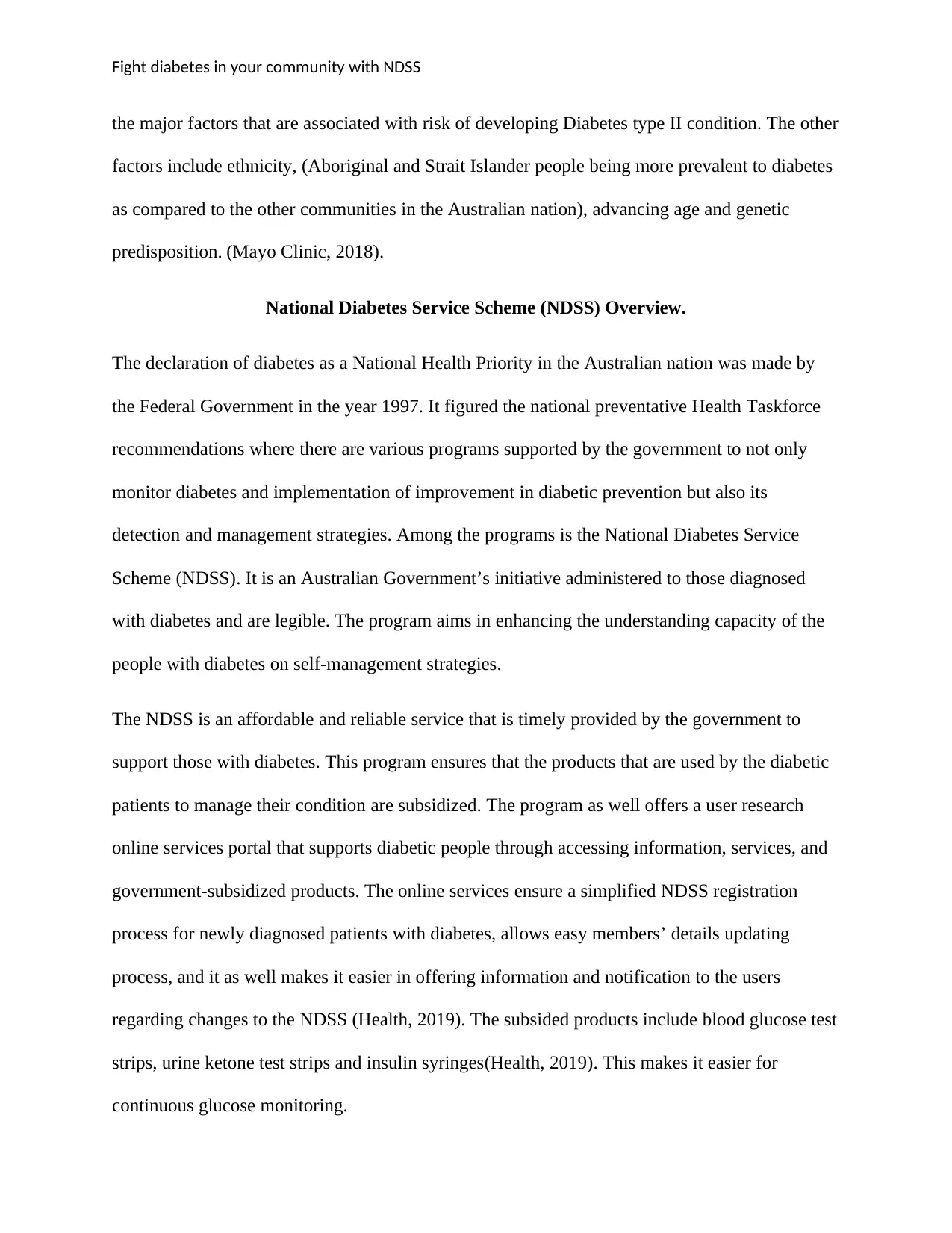
Fight diabetes in your community with NDSS
the major factors that are associated with risk of developing Diabetes type II condition. The other
factors include ethnicity, (Aboriginal and Strait Islander people being more prevalent to diabetes
as compared to the other communities in the Australian nation), advancing age and genetic
predisposition. (Mayo Clinic, 2018).
National Diabetes Service Scheme (NDSS) Overview.
The declaration of diabetes as a National Health Priority in the Australian nation was made by
the Federal Government in the year 1997. It figured the national preventative Health Taskforce
recommendations where there are various programs supported by the government to not only
monitor diabetes and implementation of improvement in diabetic prevention but also its
detection and management strategies. Among the programs is the National Diabetes Service
Scheme (NDSS). It is an Australian Government’s initiative administered to those diagnosed
with diabetes and are legible. The program aims in enhancing the understanding capacity of the
people with diabetes on self-management strategies.
The NDSS is an affordable and reliable service that is timely provided by the government to
support those with diabetes. This program ensures that the products that are used by the diabetic
patients to manage their condition are subsidized. The program as well offers a user research
online services portal that supports diabetic people through accessing information, services, and
government-subsidized products. The online services ensure a simplified NDSS registration
process for newly diagnosed patients with diabetes, allows easy members’ details updating
process, and it as well makes it easier in offering information and notification to the users
regarding changes to the NDSS (Health, 2019). The subsided products include blood glucose test
strips, urine ketone test strips and insulin syringes(Health, 2019). This makes it easier for
continuous glucose monitoring.
the major factors that are associated with risk of developing Diabetes type II condition. The other
factors include ethnicity, (Aboriginal and Strait Islander people being more prevalent to diabetes
as compared to the other communities in the Australian nation), advancing age and genetic
predisposition. (Mayo Clinic, 2018).
National Diabetes Service Scheme (NDSS) Overview.
The declaration of diabetes as a National Health Priority in the Australian nation was made by
the Federal Government in the year 1997. It figured the national preventative Health Taskforce
recommendations where there are various programs supported by the government to not only
monitor diabetes and implementation of improvement in diabetic prevention but also its
detection and management strategies. Among the programs is the National Diabetes Service
Scheme (NDSS). It is an Australian Government’s initiative administered to those diagnosed
with diabetes and are legible. The program aims in enhancing the understanding capacity of the
people with diabetes on self-management strategies.
The NDSS is an affordable and reliable service that is timely provided by the government to
support those with diabetes. This program ensures that the products that are used by the diabetic
patients to manage their condition are subsidized. The program as well offers a user research
online services portal that supports diabetic people through accessing information, services, and
government-subsidized products. The online services ensure a simplified NDSS registration
process for newly diagnosed patients with diabetes, allows easy members’ details updating
process, and it as well makes it easier in offering information and notification to the users
regarding changes to the NDSS (Health, 2019). The subsided products include blood glucose test
strips, urine ketone test strips and insulin syringes(Health, 2019). This makes it easier for
continuous glucose monitoring.
Paraphrase This Document
Need a fresh take? Get an instant paraphrase of this document with our AI Paraphraser
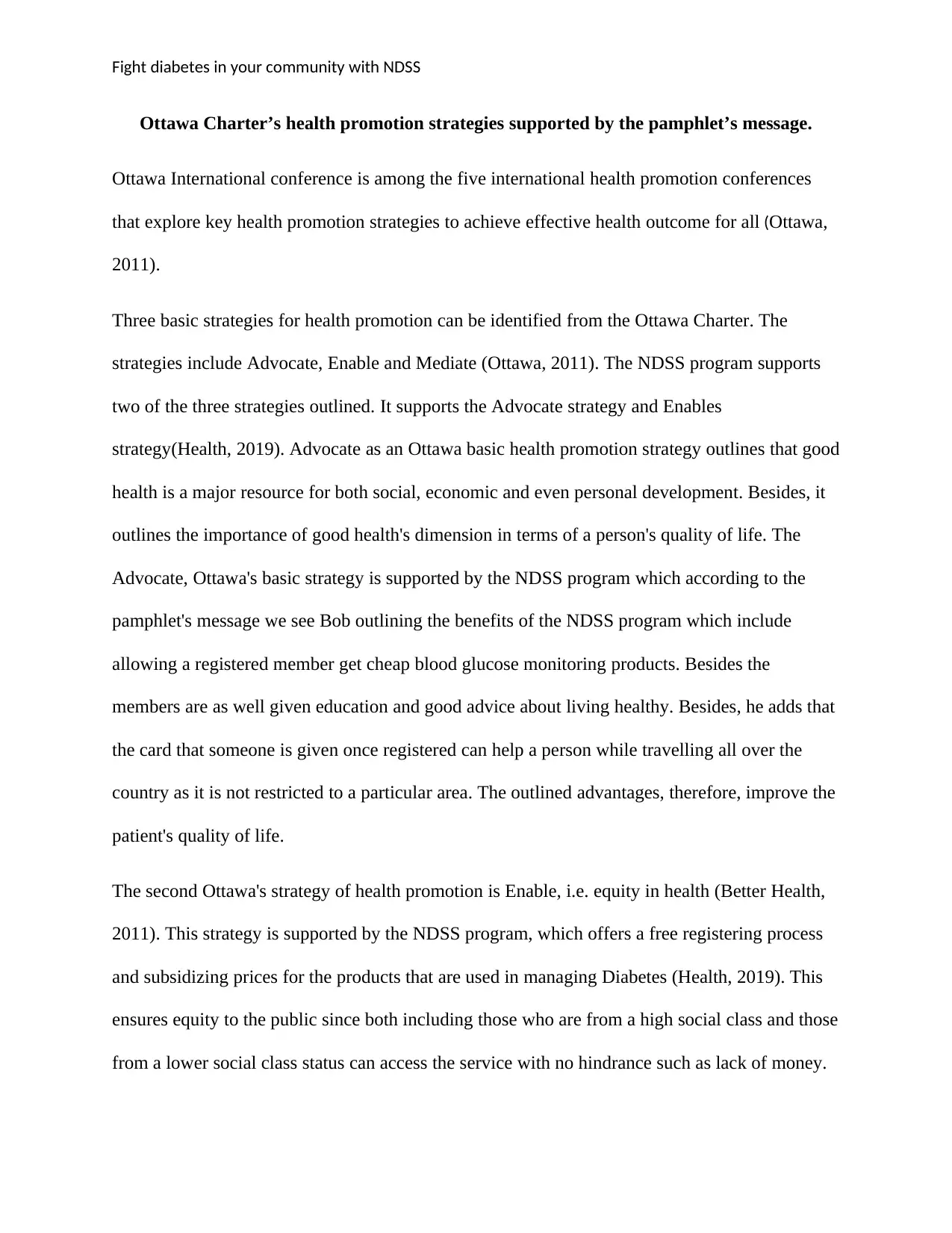
Fight diabetes in your community with NDSS
Ottawa Charter’s health promotion strategies supported by the pamphlet’s message.
Ottawa International conference is among the five international health promotion conferences
that explore key health promotion strategies to achieve effective health outcome for all (Ottawa,
2011).
Three basic strategies for health promotion can be identified from the Ottawa Charter. The
strategies include Advocate, Enable and Mediate (Ottawa, 2011). The NDSS program supports
two of the three strategies outlined. It supports the Advocate strategy and Enables
strategy(Health, 2019). Advocate as an Ottawa basic health promotion strategy outlines that good
health is a major resource for both social, economic and even personal development. Besides, it
outlines the importance of good health's dimension in terms of a person's quality of life. The
Advocate, Ottawa's basic strategy is supported by the NDSS program which according to the
pamphlet's message we see Bob outlining the benefits of the NDSS program which include
allowing a registered member get cheap blood glucose monitoring products. Besides the
members are as well given education and good advice about living healthy. Besides, he adds that
the card that someone is given once registered can help a person while travelling all over the
country as it is not restricted to a particular area. The outlined advantages, therefore, improve the
patient's quality of life.
The second Ottawa's strategy of health promotion is Enable, i.e. equity in health (Better Health,
2011). This strategy is supported by the NDSS program, which offers a free registering process
and subsidizing prices for the products that are used in managing Diabetes (Health, 2019). This
ensures equity to the public since both including those who are from a high social class and those
from a lower social class status can access the service with no hindrance such as lack of money.
Ottawa Charter’s health promotion strategies supported by the pamphlet’s message.
Ottawa International conference is among the five international health promotion conferences
that explore key health promotion strategies to achieve effective health outcome for all (Ottawa,
2011).
Three basic strategies for health promotion can be identified from the Ottawa Charter. The
strategies include Advocate, Enable and Mediate (Ottawa, 2011). The NDSS program supports
two of the three strategies outlined. It supports the Advocate strategy and Enables
strategy(Health, 2019). Advocate as an Ottawa basic health promotion strategy outlines that good
health is a major resource for both social, economic and even personal development. Besides, it
outlines the importance of good health's dimension in terms of a person's quality of life. The
Advocate, Ottawa's basic strategy is supported by the NDSS program which according to the
pamphlet's message we see Bob outlining the benefits of the NDSS program which include
allowing a registered member get cheap blood glucose monitoring products. Besides the
members are as well given education and good advice about living healthy. Besides, he adds that
the card that someone is given once registered can help a person while travelling all over the
country as it is not restricted to a particular area. The outlined advantages, therefore, improve the
patient's quality of life.
The second Ottawa's strategy of health promotion is Enable, i.e. equity in health (Better Health,
2011). This strategy is supported by the NDSS program, which offers a free registering process
and subsidizing prices for the products that are used in managing Diabetes (Health, 2019). This
ensures equity to the public since both including those who are from a high social class and those
from a lower social class status can access the service with no hindrance such as lack of money.
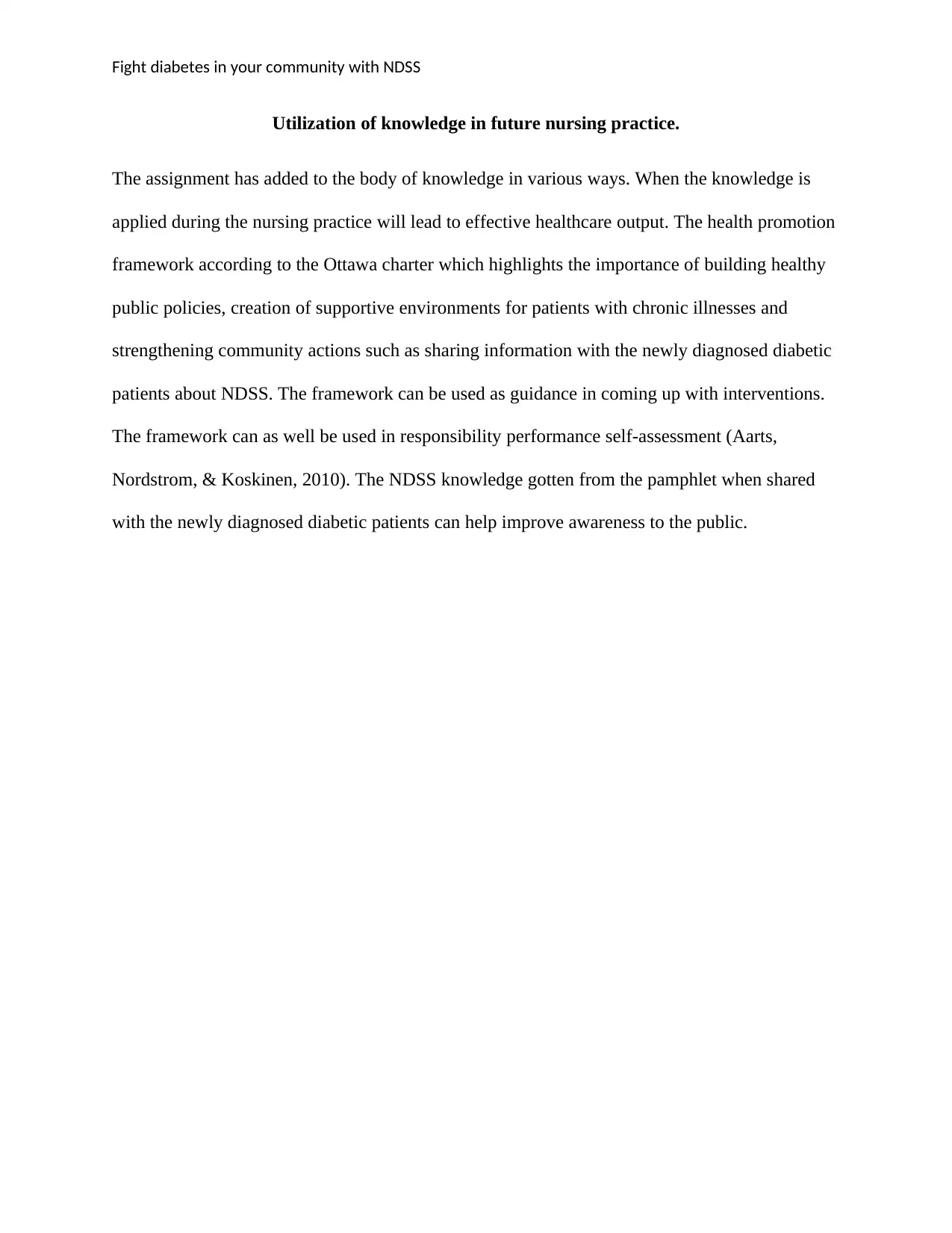
Fight diabetes in your community with NDSS
Utilization of knowledge in future nursing practice.
The assignment has added to the body of knowledge in various ways. When the knowledge is
applied during the nursing practice will lead to effective healthcare output. The health promotion
framework according to the Ottawa charter which highlights the importance of building healthy
public policies, creation of supportive environments for patients with chronic illnesses and
strengthening community actions such as sharing information with the newly diagnosed diabetic
patients about NDSS. The framework can be used as guidance in coming up with interventions.
The framework can as well be used in responsibility performance self-assessment (Aarts,
Nordstrom, & Koskinen, 2010). The NDSS knowledge gotten from the pamphlet when shared
with the newly diagnosed diabetic patients can help improve awareness to the public.
Utilization of knowledge in future nursing practice.
The assignment has added to the body of knowledge in various ways. When the knowledge is
applied during the nursing practice will lead to effective healthcare output. The health promotion
framework according to the Ottawa charter which highlights the importance of building healthy
public policies, creation of supportive environments for patients with chronic illnesses and
strengthening community actions such as sharing information with the newly diagnosed diabetic
patients about NDSS. The framework can be used as guidance in coming up with interventions.
The framework can as well be used in responsibility performance self-assessment (Aarts,
Nordstrom, & Koskinen, 2010). The NDSS knowledge gotten from the pamphlet when shared
with the newly diagnosed diabetic patients can help improve awareness to the public.
⊘ This is a preview!⊘
Do you want full access?
Subscribe today to unlock all pages.

Trusted by 1+ million students worldwide
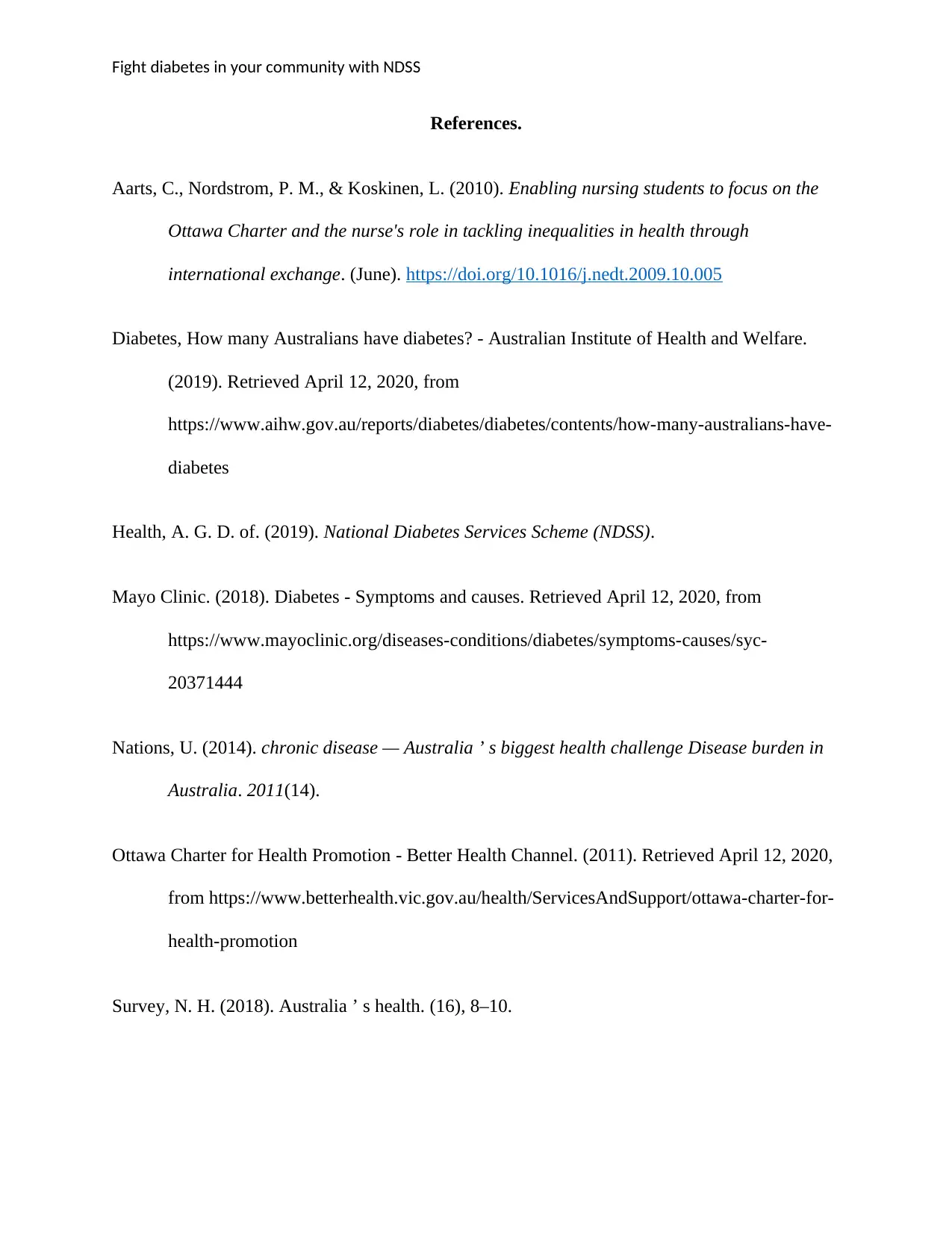
Fight diabetes in your community with NDSS
References.
Aarts, C., Nordstrom, P. M., & Koskinen, L. (2010). Enabling nursing students to focus on the
Ottawa Charter and the nurse's role in tackling inequalities in health through
international exchange. (June). https://doi.org/10.1016/j.nedt.2009.10.005
Diabetes, How many Australians have diabetes? - Australian Institute of Health and Welfare.
(2019). Retrieved April 12, 2020, from
https://www.aihw.gov.au/reports/diabetes/diabetes/contents/how-many-australians-have-
diabetes
Health, A. G. D. of. (2019). National Diabetes Services Scheme (NDSS).
Mayo Clinic. (2018). Diabetes - Symptoms and causes. Retrieved April 12, 2020, from
https://www.mayoclinic.org/diseases-conditions/diabetes/symptoms-causes/syc-
20371444
Nations, U. (2014). chronic disease — Australia ’ s biggest health challenge Disease burden in
Australia. 2011(14).
Ottawa Charter for Health Promotion - Better Health Channel. (2011). Retrieved April 12, 2020,
from https://www.betterhealth.vic.gov.au/health/ServicesAndSupport/ottawa-charter-for-
health-promotion
Survey, N. H. (2018). Australia ’ s health. (16), 8–10.
References.
Aarts, C., Nordstrom, P. M., & Koskinen, L. (2010). Enabling nursing students to focus on the
Ottawa Charter and the nurse's role in tackling inequalities in health through
international exchange. (June). https://doi.org/10.1016/j.nedt.2009.10.005
Diabetes, How many Australians have diabetes? - Australian Institute of Health and Welfare.
(2019). Retrieved April 12, 2020, from
https://www.aihw.gov.au/reports/diabetes/diabetes/contents/how-many-australians-have-
diabetes
Health, A. G. D. of. (2019). National Diabetes Services Scheme (NDSS).
Mayo Clinic. (2018). Diabetes - Symptoms and causes. Retrieved April 12, 2020, from
https://www.mayoclinic.org/diseases-conditions/diabetes/symptoms-causes/syc-
20371444
Nations, U. (2014). chronic disease — Australia ’ s biggest health challenge Disease burden in
Australia. 2011(14).
Ottawa Charter for Health Promotion - Better Health Channel. (2011). Retrieved April 12, 2020,
from https://www.betterhealth.vic.gov.au/health/ServicesAndSupport/ottawa-charter-for-
health-promotion
Survey, N. H. (2018). Australia ’ s health. (16), 8–10.
Paraphrase This Document
Need a fresh take? Get an instant paraphrase of this document with our AI Paraphraser

Fight diabetes in your community with NDSS
1 out of 8
Related Documents
Your All-in-One AI-Powered Toolkit for Academic Success.
+13062052269
info@desklib.com
Available 24*7 on WhatsApp / Email
![[object Object]](/_next/static/media/star-bottom.7253800d.svg)
Unlock your academic potential
Copyright © 2020–2025 A2Z Services. All Rights Reserved. Developed and managed by ZUCOL.





